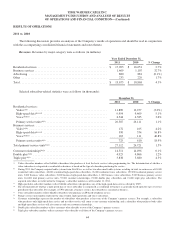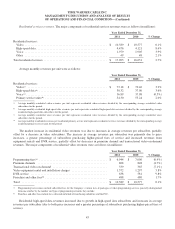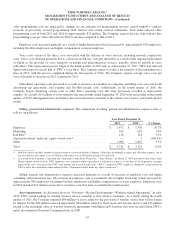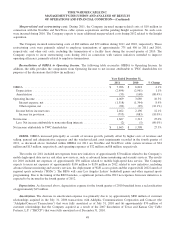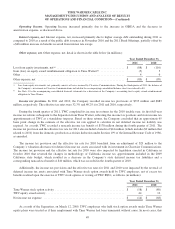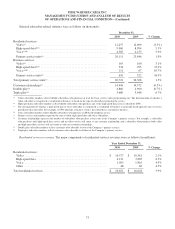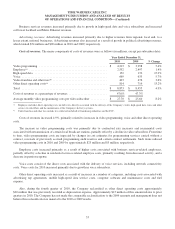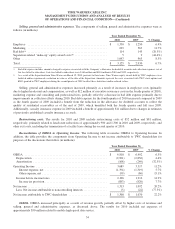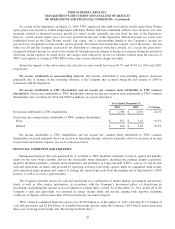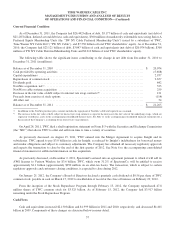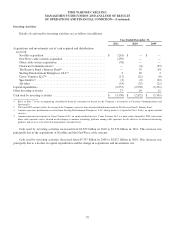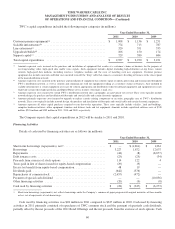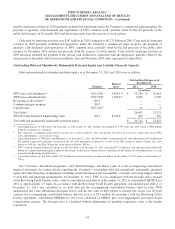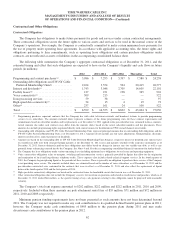Time Warner Cable 2011 Annual Report Download - page 61
Download and view the complete annual report
Please find page 61 of the 2011 Time Warner Cable annual report below. You can navigate through the pages in the report by either clicking on the pages listed below, or by using the keyword search tool below to find specific information within the annual report.
TIME WARNER CABLE INC.
MANAGEMENT’S DISCUSSION AND ANALYSIS OF RESULTS
OF OPERATIONS AND FINANCIAL CONDITION—(Continued)
Business services revenues increased primarily due to growth in high-speed data and voice subscribers and increased
cell tower backhaul and Metro Ethernet revenues.
Advertising revenues. Advertising revenues increased primarily due to higher revenues from regional, local and, to a
lesser extent, national businesses. Advertising revenues also increased as a result of growth in political advertising revenues,
which totaled $74 million and $20 million in 2010 and 2009, respectively.
Costs of revenues. The major components of costs of revenues were as follows (in millions, except per subscriber data):
Year Ended December 31,
2010 2009 % Change
Video programming .............................................. $ 4,213 $ 3,998 5.4%
Employee(a) ..................................................... 2,532 2,497 1.4%
High-speed data ................................................. 152 132 15.2%
Voice .......................................................... 669 633 5.7%
Video franchise and other fees(b) ..................................... 493 476 3.6%
Other direct operating costs(a) ....................................... 814 719 13.2%
Total .......................................................... $ 8,873 $ 8,455 4.9%
Costs of revenues as a percentage of revenues .......................... 47.0% 47.3%
Average monthly video programming costs per video subscriber ........... $ 27.70 $ 25.60 8.2%
(a) Employee and other direct operating costs include costs directly associated with the delivery of the Company’s video, high-speed data, voice and other
services to subscribers and the maintenance of the Company’s delivery systems.
(b) Video franchise and other fees include fees collected on behalf of franchising authorities and the FCC.
Costs of revenues increased 4.9%, primarily related to increases in video programming, voice and other direct operating
costs.
The increase in video programming costs was primarily due to contractual rate increases and incremental costs
associated with retransmission of certain local broadcast stations, partially offset by a decline in video subscribers. From time
to time, video programming costs are impacted by changes in cost estimates for programming services carried without a
contract, reversals of previously accrued programming audit reserves and certain contract settlements. Such items reduced
video programming costs in 2010 and 2009 by approximately $25 million and $5 million, respectively.
Employee costs increased primarily as a result of higher costs associated with business services-related employees,
partially offset by a decline in residential services-related employee costs, primarily resulting from decreased activity, and a
decrease in pension expense.
Voice costs consist of the direct costs associated with the delivery of voice services, including network connectivity
costs. Voice costs for 2010 increased primarily due to growth in voice subscribers.
Other direct operating costs increased as a result of increases in a number of categories, including costs associated with
advertising rep agreements, mobile high-speed data service costs, computer software and maintenance costs and fuel
expense.
Also, during the fourth quarter of 2010, the Company reclassified as other direct operating costs approximately
$20 million that was previously recorded as depreciation expense. Approximately $15 million of this amount relates to prior
quarters in 2010. The Company has not made the comparable reclassification to the 2009 amounts and management does not
believe this reclassification is material to the 2010 or 2009 results.
53



